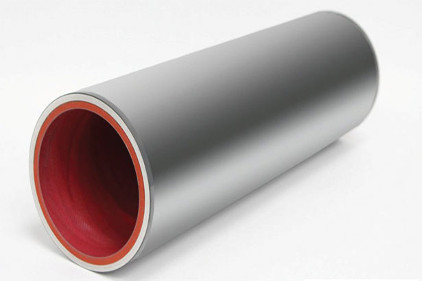 Harper Corporation of America announces the release of a new feature that is anticipated to provide clients with a wide range of benefits. Instead of using metal end rings, Harper has pioneered the use of synthetic rubber to seal and protect the numerous layers within the anilox sleeve. The synthetic rubber easily replaces the aluminum end rings that are currently found on most anilox sleeves. The grade of this material is capable of withstanding the severe stresses, temperatures, and chemicals that are involved in the flexographic printing process. The basic function of the synthetic rubber feature is to seal the expansion foam layer to prevent it from deteriorating. The synthetic rubber has allowed the cladding to cover the full thickness and length of the sleeve, eliminating the counter bore and increasing the number of reconditions that a sleeve can undergo in its life cycle. The inner liner is also extended and installation has been streamlined, as the mandrel air holes are covered more easily than when using a traditional end ring sleeve. The ability to seal the mandrel also allows the synthetic rubber to keep ink from seeping in. Currently, this new feature is only available on OEM sleeve designs that do not encompass drilled and tapped holes.
Harper Corporation of America announces the release of a new feature that is anticipated to provide clients with a wide range of benefits. Instead of using metal end rings, Harper has pioneered the use of synthetic rubber to seal and protect the numerous layers within the anilox sleeve. The synthetic rubber easily replaces the aluminum end rings that are currently found on most anilox sleeves. The grade of this material is capable of withstanding the severe stresses, temperatures, and chemicals that are involved in the flexographic printing process. The basic function of the synthetic rubber feature is to seal the expansion foam layer to prevent it from deteriorating. The synthetic rubber has allowed the cladding to cover the full thickness and length of the sleeve, eliminating the counter bore and increasing the number of reconditions that a sleeve can undergo in its life cycle. The inner liner is also extended and installation has been streamlined, as the mandrel air holes are covered more easily than when using a traditional end ring sleeve. The ability to seal the mandrel also allows the synthetic rubber to keep ink from seeping in. Currently, this new feature is only available on OEM sleeve designs that do not encompass drilled and tapped holes.
Harper Corporation of America announces the release of a new feature that is anticipated to provide clients with a wide range of benefits. Instead of using metal end rings, Harper has pioneered the use of synthetic rubber to seal and protect the numerous layers within the anilox sleeve. The synthetic rubber easily replaces the aluminum end rings that are currently found on most anilox sleeves. The grade of this material is capable of withstanding the severe stresses, temperatures, and chemicals that are involved in the flexographic printing process. The basic function of the synthetic rubber feature is to seal the expansion foam layer to prevent it from deteriorating. The synthetic rubber has allowed the cladding to cover the full thickness and length of the sleeve, eliminating the counter bore and increasing the number of reconditions that a sleeve can undergo in its life cycle. The inner liner is also extended and installation has been streamlined, as the mandrel air holes are covered more easily than when using a traditional end ring sleeve. The ability to seal the mandrel also allows the synthetic rubber to keep ink from seeping in. Currently, this new feature is only available on OEM sleeve designs that do not encompass drilled and tapped holes.
Harper Corporation of America
(800) 438-3111; www.harperscientif.com








